Chronotropic heart rate - Study guides, Class notes & Summaries
Looking for the best study guides, study notes and summaries about Chronotropic heart rate? On this page you'll find 596 study documents about Chronotropic heart rate.
Page 3 out of 596 results
Sort by
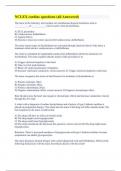
-
NCLEX cardiac questions (all Answered)
- Exam (elaborations) • 13 pages • 2024
-
Available in package deal
-
- $10.99
- + learn more
The nurse in the telemetry unit explains two nonpharmacological treatments such as ___________, or ___________, can be used to treat dysrhythmias. A) ECG; pacemaker B) Cardioversion; defibrillation C) Aspirin; Plavix D) Exercise; stress test correct answers B) Cardioversion; defibrillation The more serious types of dysrhythmias are corrected through electrical shock of the heart, a treatment called elective cardioversion, or defibrillation. The client is scheduled for implantable car...
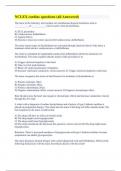
-
NCLEX cardiac questions (all Answered)
- Exam (elaborations) • 13 pages • 2024
-
Available in package deal
-
- $10.99
- + learn more
The nurse in the telemetry unit explains two nonpharmacological treatments such as ___________, or ___________, can be used to treat dysrhythmias. A) ECG; pacemaker B) Cardioversion; defibrillation C) Aspirin; Plavix D) Exercise; stress test correct answers B) Cardioversion; defibrillation The more serious types of dysrhythmias are corrected through electrical shock of the heart, a treatment called elective cardioversion, or defibrillation. The client is scheduled for implantable car...
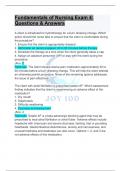
-
Exam 4: Fundamentals of Nursing Exam 4: Questions & Answers: Updated : Guaranteed A+
- Exam (elaborations) • 34 pages • 2024
- Available in package deal
-
- $7.99
- + learn more
A client is scheduled for hydrotherapy for a burn dressing change. Which action should the nurse take to ensure that the client is comfortable during the procedure? 1. Ensure that the client is appropriately dressed 2. Administer an opioid analgesic 30 to 60 minutes before therapy 3. Schedule the therapy at a time when the client generally takes a nap 4. Assign an assistive personnel (AP) to stay with the client during the procedure (Ans- 2 Rationale: The client should receive pain medica...
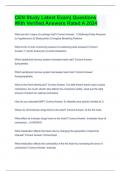
-
CEN Study Latest Exam| Questions With Verified Answers Rated A 2024
- Exam (elaborations) • 39 pages • 2024
- Available in package deal
-
- $10.48
- + learn more
CEN Study Latest Exam| Questions With Verified Answers Rated A 2024 What are the 3 signs of cushings triad? Correct Answer: 1) Widening Pulse Pressure (or hypotension) 2) Bradycardia 3) Irregular Breathing Patterns What is the 2 most concerning causes of a widening pulse pressure? Correct Answer: 1) Aortic Aneurysm 2) Aortic Dissection Which peripheral nervous system increases heart rate? Correct Answer: Sympathetic Which peripheral nervous system decreases heart rate? Correct Answ...
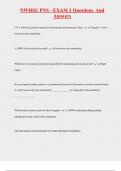
-
NWHSU PNS - EXAM 3 Questions And Answers
- Exam (elaborations) • 36 pages • 2024
- Available in package deal
-
- $18.99
- + learn more
NWHSU PNS - EXAM 3 Questions And Answers CN X will have (positive/negative) chronotropic and ionotropic effect. Negative - lower heart rate and contractility. A sIPSP will do what to the heart? lower rate and contractility. Which nerve and side is primarily responsible for maintaining resting heart rate? Right Vagus. In a g-coupled receptor system, it is common for the end of the chain to activate a protein kinase A, which causes this type of potential ______________, by doing this t...
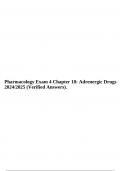
-
Pharmacology Exam 4 Chapter 18: Adrenergic Drugs 2024/2025 (Verified Answers).
- Exam (elaborations) • 47 pages • 2024
-
- $12.99
- + learn more
Pharmacology Exam 4 Chapter 18: Adrenergic Drugs 2024/2025 (Verified Answers). Chapter 18: Adrenergic Drugs 1. The nurse is aware that adrenergic drugs produce effects similar to which of these nervous systems? a. Central nervous system b. Somatic nervous system c. Sympathetic nervous system d. Parasympathetic nervous system Adrenergic drugs mimic the effects of the sympathetic nervous system. 2. When an adrenergic drug stimulates beta1-adrenergic receptors, the result is an increased f...

-
Rush NSG 531 Advanced Pharmacology Exam 2 Questions & Answers
- Exam (elaborations) • 5 pages • 2024
-
- $10.99
- + learn more
Beta 1 receptors - - Heart: increase cardiac rate (chronotropic) and increase force of contraction (inotropic) Juxtaglomerular cells: increase renin release Isoproterenol - - Beta 1 prototypic agonist; nonselective, used for bronchodilation (beta 2) and cardiac stimulant (beta 1) Metoprolol - - Beta 1 prototypic antagonist Heart: reduces rate and force of contraction, inhibits impulse conduction Kidney: suppresses renin secretion
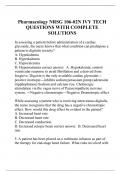
-
Pharmacology NRSG 106-02N IVY TECH QUESTIONS WITH COMPLETE SOLUTIONS
- Exam (elaborations) • 32 pages • 2023
-
Available in package deal
-
- $15.99
- + learn more
In assessing a patient before administration of a cardiac glycoside, the nurse knows that what condition can predispose a patient to digitalis toxicity? A. Hypokalemia B. Hyperkalemia C. Hypocalcemia D. Hypernatremia correct answer: A. Hypokalemia; control ventricular response to atrial fibrillation and a derived from foxglove. Digoxin is the only available cardiac glycoside---positive inotropic---inhibits sodium potassium pump (adenosine tripphophatase) Sodium and calcium rise. Cholinergic...
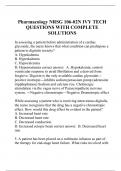
-
Pharmacology NRSG 106-02N IVY TECH QUESTIONS WITH COMPLETE SOLUTIONS
- Exam (elaborations) • 32 pages • 2023
-
- $15.99
- + learn more
In assessing a patient before administration of a cardiac glycoside, the nurse knows that what condition can predispose a patient to digitalis toxicity? A. Hypokalemia B. Hyperkalemia C. Hypocalcemia D. Hypernatremia correct answer: A. Hypokalemia; control ventricular response to atrial fibrillation and a derived from foxglove. Digoxin is the only available cardiac glycoside---positive inotropic---inhibits sodium potassium pump (adenosine tripphophatase) Sodium and calcium rise. Cholinergic...
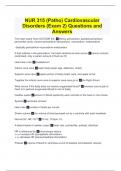
-
NUR 315 (Patho) Cardiovascular Disorders (Exam 2) Questions and Answers
- Exam (elaborations) • 32 pages • 2024
-
Available in package deal
-
- $13.99
- + learn more
The heart layers (from OUTSIDE-IN): fibrous pericardium, parietal pericardium, pericardial cavity, visceral pericardium (epicardium), myocardium, endocardium ~basically pericardium-myocardium-endocardiun If fluid collects in the pericardium, the heart stretches & what occurs cannot contract (restricted)- only a certain amount of fluid can fill Heart lies in the mediastinum Inferior vena cava lower body (lower legs, abdomen, chest) Superior vena cava upper portion of body (head, neck, and up...

Study stress? For sellers on Stuvia, these are actually golden times. KA-CHING! Earn from your study resources too and start uploading now. Discover all about earning on Stuvia


